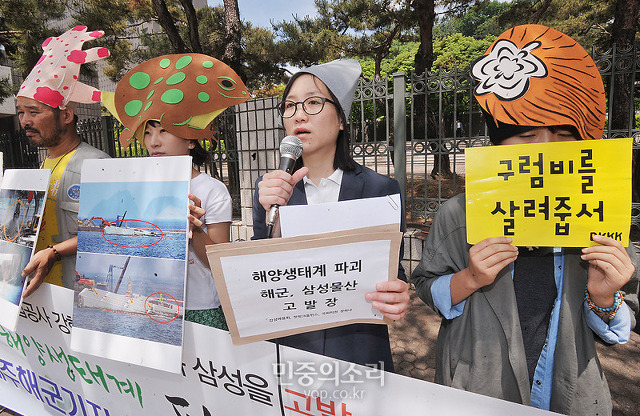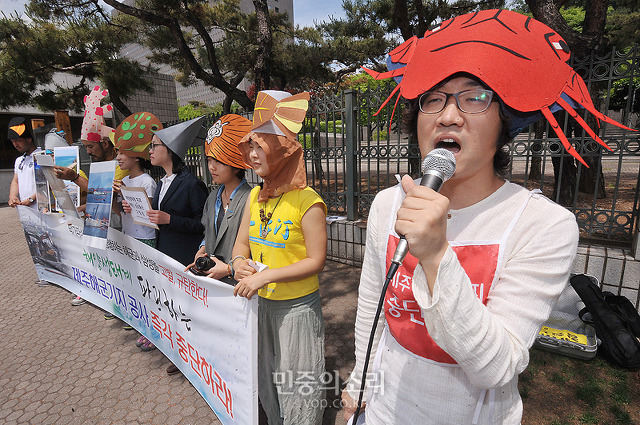In this month’s issue:
Grand March for Life and Peace 2013, August 4th Human Chain, Oliver Stones Visits Jeju, Navy wants to expand base site size, Prison letter from Kim Young-Jae, Trial, prison, and hospital updates, solidarity reports from Taiwan and Philippines and more!
Save Jeju Now
No War Base on the Island of Peace
Tag: Jeju
-
3rd Jeju DMZ Peace Island Meeting to be Held in Moseulpo

Korean banner for the 3rd meeting. Tomorrow, August 15, 2013, the 3rd meeting of the movement to demilitarize Jeju “Jeju, the Demilitarized Peace Island” will meet. This meeting open to everyone will take place from 10 a.m. to 3 p.m. in Moseulpo, on the southwest cost of Jeju.
Moseulpo is an important place in the history of military and anti-militarist struggles on Jeju. During the Japanese colonization, the residents were forced to large caves out of the coastal cliffs of Mt. Songak to store torpedos to be used for attacks on allied forces in WW2, a part of Japans broader massive military build up of Jeju in anticipation of a stand off that fortunately never happened. Nearby is the abandoned Alddreu Airfield, also set up by the Japanese military for bombing China.

Caves along the cliff face of Mt. Songak. Later during 4.3 and Korean War, Moseulpo, like most of Jeju was also the site to several massacres including the Massacre at Seotal Oreum. In 1950, The Moseulpo Police had arbitrarily detained 344 people in the police station, a fishing storage, and a potato storage. 211 of the detained were eventually slaughtered without any legal process and secretly buried. 20 people were killed on July 16 and 193 on August 20. 41 other people went missing.
Later from 1987-1989, the Korean government attempted to build an air-force base on Mt. Songak, but strong local resistance won after a two year struggle and the plans were scrapped. However, the Korean Ministry of National Defense still owns land in the area and recently there was has been rumors that they again plan to build an airfare base there, perhaps on part of the old Alddreu Airfield (part of which has been declared a national heritage site). Meanwhile, the ROK MND has a small radar base in Moseulpo, formerly the U.S. owned Camp McNabb (for 53 years until it was taken over by Korean in 2005.

Moseulpo Radar Base, formerly U.S. Camp McNabb. In light of this history of oppression and resistance, Moseulpo is a key location for the movement to demilitarize Jeju.
Peace loving people from across Jeju and Korea will come together to tour the historical sites, hear about the successful struggle against the air-force base and discuss and plan the demilitarization of Jeju. Join us!
Contact gangjeongintl@gmail.com for for details.
-
Gangjeong in the International Dialogue Conference on “Seeking Peace from Oceanic Perspectives” in Taipei, Taiwan
On August 3rd, the International Dialogue Conference on “Seeking Peace from Oceanic Perspectives” was held in Taipei, Taiwan. Emily Wang was one of the speaker in the secession of “An Oceanic Deconstruction of Geopolitics” to share about Gangjeong and the idea of Inter-Island Solidarity for Just Peace.

Distribute the Gangjeong Newspaper 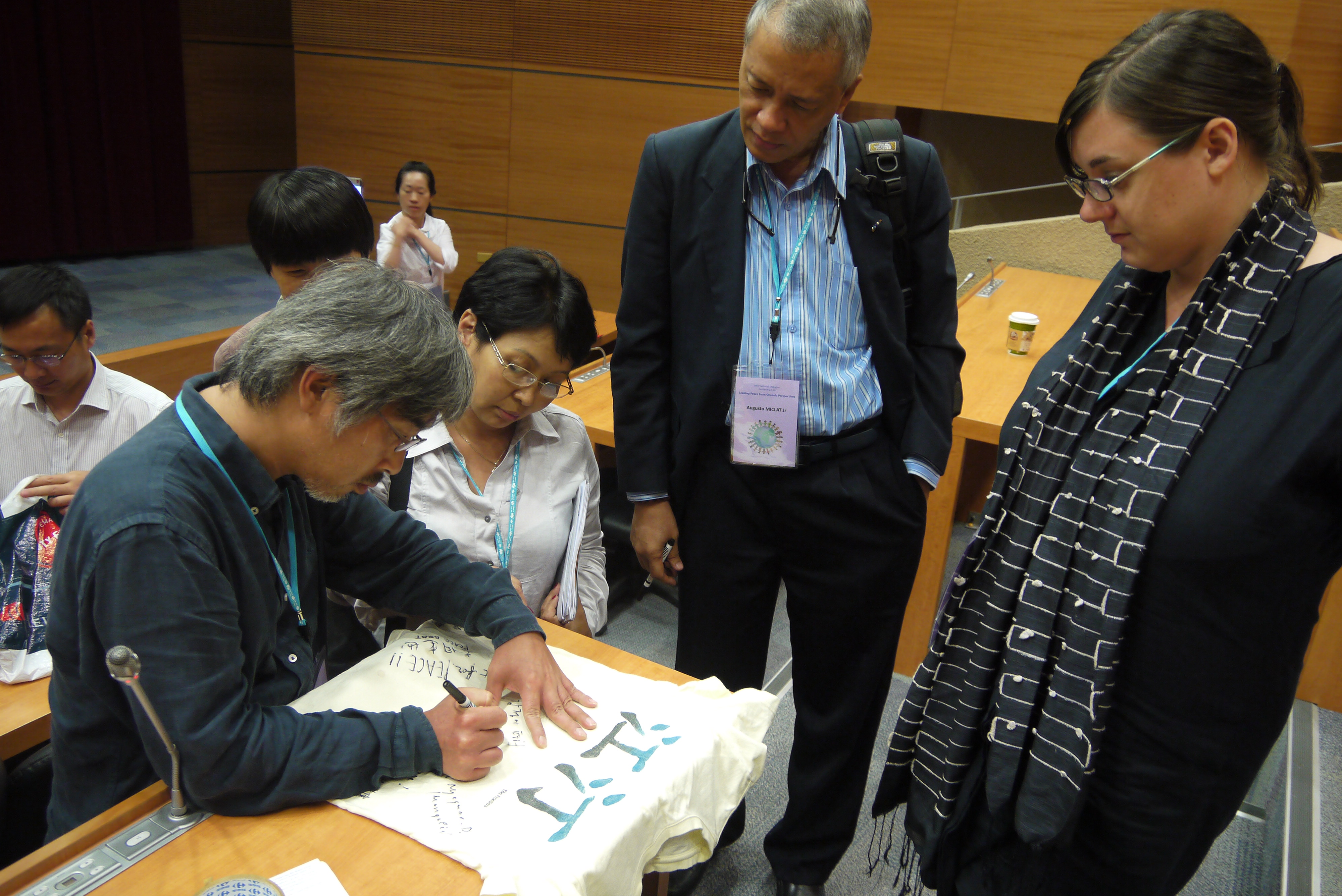
People were writing the messages to Gangjeong The following is the speech draft of Emily Wang.
————–
By Emily Wang
My name is Emily Wang. I am an island peace activist from Taiwan Island and also I’ve ever lived and worked for peace on Timor Island for 1 year, and Jeju Island for almost 2 years, and I just got deported by the South Korea government in April 2013 due to my involvement in the Peace Movement in Gangjeong Village, Jeju Island where a major naval base is being built up. Thanks to the deportation, I got depressed for a while because I had to leave my friends and family. But also it gives me a chance to move forward in my next steps as an island peace activist.
Today’s topic is “An Oceanic Deconstruction of Geopolitics”. I would like to begin by sharing about “islands”, and I think the long suffering of many islands will provide an inspiring source to deconstruct geopolitics and for the peace in our region.
One of the crucial challenges of many peaceful and beautiful islands face is the trend of military expansion and militarization, largely by the U.S. Military. This has led to conflict, suffering, and environmental destruction in such places as Okinawa, Hawaii, Diego Garcia, Sprately Islands, Jeju (Korea), Guam, and others.
The situation which the islands face has been getting worse since the US launched the “Asia Pivot” strategy. Many islands are going to be further militarized, for example in North East Asia, Jeju and Okinawa. Besides Northeast Asia, there is other bad news to worry about. For example, The Philippines’ government now plans to invite back the US military they once kicked out to use their base again. The US is strengthening its partnership with these countries and following the strengthened partnership, these countries self-colonize themselves from the center to further marginalize and victimizes the small islands.
These islands are like “LilyPads” in the ocean used to allow military bases encircle the land to prepare for possible war in the future. Compared to a huge base, lots of small bases are spread across these lily pads, a strategy that is more flexible, attracts less attention, and allows for easier defeat of grass-roots resistance. In the past continuing until now, we have seen many islands face hardships in resistance due to the isolation of these small islands. Therefore, we need to develop inter-island solidarity for just peace among vulnerable islands and their peoples, for the protection of their lands, cultures, and traditions, as well as to find common strengths and resources for peace and just life. “Just peace” is our pursuit. We want to stop the current on-going militarization and while preparing other islands to prevent this possibility in advance. These struggles are not NIMBYs. One success shouldn’t come through another island being victimized.
I was a peace school teacher in Timor Island in the past, and recently I visited Timor again to share this idea of inter-island solidarity for just peace. During this visit, I heard that the US had a plan to use Timor-Leste’s Atauro Island for a base, while promising to build lots of infrastructure for this newly-independent country. So far, the government rejected, but this worry remains in my mind. Now, I am at the Northeast Asia GPPAC meeting, but I am also talking about another beloved island far away. These islands are too spread out, too small, and have so far mostly faced lonely struggles. I think especially for islands, we should not let national sovereignty divide the continuance of ocean.
In Northeast Asia, we dream of first starting with a Peace Island Triangle consisting of Okinawa, Jeju and Taiwan. What I mean by peace island is demilitarized peace islands. No bases, no militaries, no conscription, no state violence, and no domestic colonization or marginalization…
A long time ago, Jeju, Okinawa, and Taiwan were embraced by the ocean and developed unique cultures. Then influence and exchange came from the main lands or big islands. Mostly islands have been “marginal” places for the “center” of the main lands or big islands, but islands as their own center have gone on their own paths from generation to generation. Then western imperialism struck our region and most of the world. Still Islands often had distinct experiences from the main lands under imperialism.
Okinawa, Jeju, and Taiwan were colonized by Imperial Japan and become the stepping-stones for the expansion of Imperial Japan. In the final moments of World War Two, Imperial Japan further fortified these islands in expectation of invasion by the US Allied Forces, dragging these marginalized islands into the war as the frontline to protect the centers of power. It brought disastrous ground battles in Okinawa and air raids in Taiwan. Jeju was highly militarized through forced labor as well but following the battle in Okinawa, did not see war at that time. However they later faced the terrible extended 4.3 Massacre.
Due to the geographic location of the island, during Japanese colonization, perhaps 200,000 Jeju people at one time or another were moved back and forth between Jeju and Osaka, the foremost industrial city in Asia at the time. There they found jobs and, for some, better education than was allowed in Korea. Frequent ferries, some organized by Jeju transportation cooperatives, carried people to Osaka from eleven ports around Jeju. In Osaka, some Jeju residents were active in organized labor and Japanese socialist and communist organizations even in leadership positions. Some 60,000 people returned from Japan to Jeju within a short time of the Japanese surrender in August 1945. The experienced and educated returnees played an important leadership role in the emerging governmental structures on Jeju.
However, soon the division of the Korean Peninsula by the United States and the Soviet Union turned Jeju into a battlefield for subsequent cold war conflicts on the peninsula. In 1948, with U.S. and U.N. support, South Korea held elections that established a separate state in the south, thus solidifying Korea’s division. When the US tried to install a Pro-US government in the south with a separate election, the Jeju people bravely stand up to protest and boycott this election and the division of Korea. When U.S. backed leader Syngman Rhee took power following the elections, he initiated a massive “Red” cleansing campaign targeted the Jeju general population. Thousands of people were killed. It is estimated that 70 percent of entire island’s villages were razed to the ground and 30,000 people—ten percent of the island’s population—were murdered.
For years, any mention of the massacre could lead to imprisonment and torture. Relatives of those who had been labeled as Communists were prevented from taking public service positions or jobs in many companies. Many are still afraid to talk about what happened. For 50 years, successive governments in Seoul silenced the Korean people’s memories of systematic murder, rape and torture. It was not until 2006 that the late President Roh Moo-Hyun officially apologized for the massacre and designated Jeju “Island of World Peace”. As one exits the Official 4.3 Peace Park Museum, a sign reads: “The Jeju April 3rd Incident will be remembered as a symbol of the preciousness of peace, unity and human rights.” But the government’s memory is short. Plans for a major naval base on Jeju had been in the works since 2002 at different locations, but opposition from local residents’ halted construction several times. The struggling of the islanders to defend their lives, lands, community is again leading to them being painted as “Reds”.
This sad history once led the people to dream of making this island a Peace Island, but we realized that without continuous non-violent efforts to realize this goal and to carry on peace education, even the islanders themselves can erase these precious memories through public education and mainstream media. Also, we learned that without walking together with the international community, our peace cannot be a just peace.
I am an islander. I’ve talked much about the victimization of islands but it is not because I hate people from mainlands or big islands and I don’t deny the suffering of mainlanders as well. The reason that I promote island peace building is because I want to build peace as who I am. Actually, my island, I mean Taiwan, itself is also a “big island” which marginalizes and victimizes smaller islands like Lanyu, where our government shamefully secretly throwsaway nuclear waste. Unlike Okinawa, Jeju, and Taiwan which have relatively long histories through the storms of power-shifting between surrounding powers, Lanyu had long been a self-governed island without interruption from outside until its colonial encounter with Imperial Japan and the Chinese Nationalist government. Social activism on the Island began from the suffering of this small island. I expect Lanyu, the Chinese name, or Ponso no Tao, as its called by its indigenous islanders can become a light to connect Taiwan to the Peace Island Triangle.
Only if peace and justice become a common goal among us, can we break our current boring and rigid situation, and blossom our creativity through peace-building.
The suffering islands are our hope. We should hold hands together with these islands regardless if you are foreigners or mainlanders. I want to emphasize that talking about Islands and Islanders is not to make division. I just want to remind us that there are some people who are embraced by the ocean but sadly this embrace by the ocean turned into the isolation by the ocean. These are issues that we should face together. I hope that islands will not only again be embraced by the ocean but also be embraced by the surrounding big lands.
I truly hope we don’t make a stupid fake peace in our region by holding hands with the US while refusing to face the historical issues that caused our region to become one of the most militarized in the world. There are many things we islanders can do as we dig through the layers of our history and seek to find a common future peace across the ocean, between the islands within it.
Thank you for listening.
-
2013 Gangjeong Grand March for Life and Peace calls you: July 29 to Aug.4
UPDATE: Please notice that the official dates are changed from July 29 to Aug. 4, Sunday.
The July 29 to Aug. 3 program with the cultural festival in the Jeju City on Aug. 3 is same. But people will gather in Gangjeong on Aug. 4 to create a human chain between the east and west tips of the naval base construction area (1,500 km) from noon to 12 pm. Click here for more details on Human Chain on the day. Dir. Cho Sung-Bong, a movie director, currently works on the acclaimed documentary on Gangjeong titled, “The Gureombi Wind Blows,” will take air camera shots on human chain scene using unmanned helicopter and will put all the names of participants in the movie’s ending credit. Even though you may not be able to physically join the march and human chain. please send us international solidarity messages(up to 100 words)/photos/videos through gangjeongintl@gmail.com by no later than July 20. All the messages will be publicly shared. Please see the bottom for the details of optional programs after the human chain on Aug. 4.

Click the poster for a larger version. * Internationals who can physically join the march and want to contribute the march with one’s talent/work, please see the below translation.
* Internationals who want to support the march by sending solidarity messages of up to 100 words and/or photos and/or videos, please send those to Gangjeongintl@gmail.com no later than July 20 (Please see the 2012 event here, and solidarity messages, here)
* For all questions and suggestions on the matters including those not explained in the below, please contact gangjeongintl@gmail.com
* Thank you to be with us!
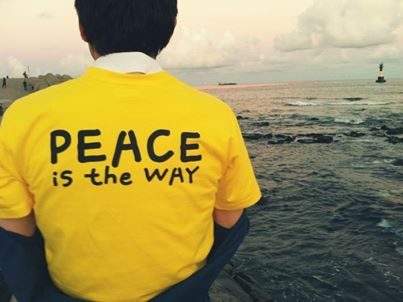
2012 Gangjeong Grand March for Life and Peace (Image: Choi Hye-Young) 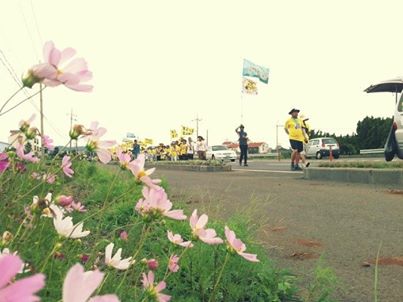
2012 Gangjeong Grand March for Life and Peace (Image: Choi Hye-Young) # A translation of most part of an original Korean script
Proposal for co-sponsoring and participation
in the 2013 Gangjeong Grand March for Life and Peace
By the Coordinating Committee for 2013 Gangjeong Grand March for Life and Peace
June 7, 2013
Summary (translated) of introduction letter
The Opposition struggle against the Jeju naval base project hits its 7th year. [..]
Since the Presidential election last time, the response measure by the prosecutors and police has been transformed into consistent drastic policies. The navy is openly enforcing construction(destruction) despite people’s criticism on illegal construction(destruction). Some make propaganda that the struggle to stop the naval base project is in fact finished as the Park Geun-Hye Government that has asserted on the justification of the Jeju naval base project was launched. [..]
Everyday is a continuation of hard struggle in Gangjeong nowadays. The police make routine of arrest and the prosecutors who are in line with them are oppressing the opposition struggle with unreasonable issuing of arrest warrants and bombs of fines. [..]
However, we cannot give up. It is because we trust that the peace of Gangjeong is the peace of Korea and our struggle to stop the Jeju naval base project is to be the voice for the peace of the northeast Asia and world. It is also because we know that the way we are walking now would be a step to stop the ‘gochak’ (meaning ‘detaining by encircling’) of destructive military domination and resuscitation of anti-human state violence. [..]
Now, we, succeeding the year of 2012, want to propose to gather people’s voice for peace once again.
We are to gather the voice to inform the injustice of the Jeju naval base project and to appeal for peace to be saved, while we walk around of the spots of Jeju for five nights six days during the hot summer.
Please join the 2013 Gangjeong Grand March for Life and Peace in which we feel pain together, walk together, and talk on our peace together!
Please be a part of one strong voice for peace, again!
Details of proposal
Please become a co-sponsoring groups for the 2013 Gangjeong Grand March for Life and Peace
□ The role of co-sponsoring group
▶ Registartion of more than 100,000 KRW (about 90~100 USD), which is for co-sponsoring of the event
▶ Each representative of co-sponsoring group is chosen as a member of the Peace Representative Board. One has to join march for more than a day
▶ Encourages its members to join the march and organizes support material and fund.
▶ It is planned that each co-sponsoring group is individually named in poster, web poster and media.
▶ The groups that have been confirmed of co-sponsoring and that are in discussion as of June, 2013:
The Gangjeong Village Association,
Jeju Pan-Island Committee for the Stop of Military Base and for Realization of Peace Island (31 groups)
National Network of Korean Civil Society for Opposing to the Naval Base in Jeju Island (11 groups)
Open Network (Inc.)
Gangjeong Friends
Gangjeong peacekeepers
Professors’ Association for the stop and re-examination of Jeju naval base construction
Korean Writers’ Association
□ Contact
Go Gwon-Il, chairman of the Gangjoeng Villagers’ Committee to Stop the Naval Base Project
Boo Jang-Won, Director of coordination, Jeju Pan-Island Committee for the Stop of Military Base and for Realization of Peace Island
Kim Duk-Jin, National Network of Korean Civil Society for Opposing to the Naval Base in Jeju Island
# For internationals, please contact Gangjeong village international team: gangjeongintl@gmail.com
□ Plan on Gangjeong Grand March for Life and Peace
I. Summary
(1). Purpose
– It is to disclose the betraying behaviors of the navy and government that enforce construction (destruction) under the false cause of ‘national security’ and Woo Keun-Min Island government that connives those and in line with them. And it is to gather the public fury on it (* The election on the Island governor is in 2014. Currently the public support on the Island governor Woo Keun-Min is low)
-It is to form a public discussion on the possibilities of militarization of Jeju by the Jeju naval base project and of occurrence of military conflict in the northeast Asia. It is to expand to the public the need of continuation of the struggle to stop the naval base project.
-It is to share the mutual relationship among state, human rights, democracy, we remembering that state violence during the 4·3 uprising is recurred during the current enforcement process of the naval base project .
(2). Title of the event
2013 Gangjeong Grand March for Life and Peace, “Let’s meet [also can be translated gather] together! Let’s walk together! Peace for Gangjeong!”
(3). Sponsor and Host
-Sponsor: The Gangjeong Village Association, Jeju Pan-Island Committee for the Stop of Military Base and for Realization of Peace Island (31 groups), National Network of Korean Civil Society for Opposing to the Naval Base in Jeju Island (11 groups) etc.
( It is expected that the titles of groups will be added in the future)
-Host: The Gangjeong Village Association, Jeju Pan-Island Committee for the Stop of Military Base and for Realization of Peace Island (31 groups), National Network of Korean Civil Society for Opposing to the Naval Base in Jeju Island (11 groups)
(4). Program
Eve festival: 7 pm, July 28 (Sunday), 2013, Village Ceremony hall, Gangjeong Village
Grand March: July 29 (Mon) to Aug. 3 (Sat), 2013: For five nights six days
Nationwide citizens’ cultural festival to demand the revocation on the Jeju naval base project: Aug. 3 (Sat), 6pm, Tapdong square, Jeju City(tentative)
Human chain between the east and west tips of the naval base project area in Gangjeong: Aug. 4 (Sun), 12 to 2 pm, Gangjeong
(5). Participation purpose
The total number of man-days participation is expected 2,000 to 3,000 (except for the participants in the cultural festivals)
( 6). Ways of March
-People will be divided by east and west teams. The pilgrim will be focused on the inner roads of towns.
-There will be explanation on main histories, ecology, and environment of each region
– Some figures concerned with Gangjeong will be asked to join the march as the members of the Peace Representative Board.
( 7). Slogan
-Main slogan: “Let’s meet [also can be translated as gather] together! Let’s walk together! Let’s shout together! Peace for Gangjeong!”
-March slogan: Will be collected by group proposal or public solicitation, TBA
II. Guide on participation
(1). Application-phone, fax, email, internet registration
Internationals may contact the Gangjeong Village International team for application: gangjeongintl@gmail.com
# All applications will be collected into the briefing room of the Gangjoeng Village Association
(2). Participation fee
1) Per one person
– 1 day participation: 10,000 won (T-shirt not included)
– 1 night 2 days~ 2 night 3 days: 30,000 won (including T-shirts)
– 3 night 4 days~6 night 7 days: 50,000 won (including T-shirts)
# No Fee. Children elementary school-aged and under (T-Shirt not included)
# All meals, one bottle of water per day, wristle (to protect from hot sunlight)
2) Bank account for participation fee and support fund
: Nonghyup 351-0603-6444-93 (Beneficiary: Gangjeong Village Association)
Internationals can pay in cash on the very day(s) of participation.
(3) Accommodation
In principle, commmon tent
However, bringing individual tent is OK
An individual should prepare for one’s sleeping bags etc.
(4) March course
– It will be about 20 Km march a day.
– As possible as even road, considered of family participants
– On the last day (Aug. 3), march as possible as all spots of Jeju City
– Detailed course will be known later.
(5) Individual participant preparation
– Sleeping bag, washing stuff, hat, individual tent(choice) etc.
III. Organization of march team
(1) March team
Peace Representative Board (5 to 10 personnel for each day), march chiefs (full and daily), overall management on march, march director(practical business), support team, medical team, guide team, record team, administration team
(2) Briefing room
Director, registration team, meal team, meal-supply team, finance team, public relation team
IV. Main event program
(1). Eve festival
– Date: 7pm, July 28(Sun), Gangjeong Village Ceremony hall
– Basis: sharing the meaning of peace and gathering the will to stop the naval base project
– Main content: resolution speech, sharing meanings, introduction of participants, concert, peace ceremony.
(2). Press conference at the start
– Date and time: 8:30 am, July 29 (Mon), Gangjeong soccer field
– Content: Statement for citizens and demand on the revocation of the naval base project
– Introduction on some figures and speeches
– Main content: Speech by representative, statement, ceremony to gathering the sea water of Jeju, photo
(3).Cultural festival in the summer night
-Date: Aug 1 in Kimnyong (east team)and Aewol (west team)
– Content: Encouragement of local residents’ participation
(4). March program
– Public solicitation on photos, writings from the 2012 march participants, prize and recognition is given (Please contact gangjeongintl@gmail.com for subscription)
– Peace postcard to oneself: read in the festival and mailing
– Collecting sea water in the main march regions: Water will be collcted in cermony in the festival.
-etc.
(5). Cultural festival to revoke the Jeju naval base project
-Date/ Time: 6 pm, Aug. 3(Sat). Topdong Square, Jeju City (planned)
(6) Peace human chain: noon to 2 pm, Aug. 4 (Sun), Gangjeong village, in front of the Jeju naval base project committee building complex ( from Gangjeong stream in th east to the Gangjeong port in the west)
* Human chain is the end of official event of the whole march
(7) Optional program in Gangjeong on Aug. 4 (Sun)
7 pm: Korean traditional yard square in front of the Gangjeong Village Ceremony Hall
After 2 pm: Taste on the Peace of Gangjeong (free trip on the places of the village, Gangjeong stream water leisure)
-
Gangjeong International Team Hosts International Solidarity Talkshow
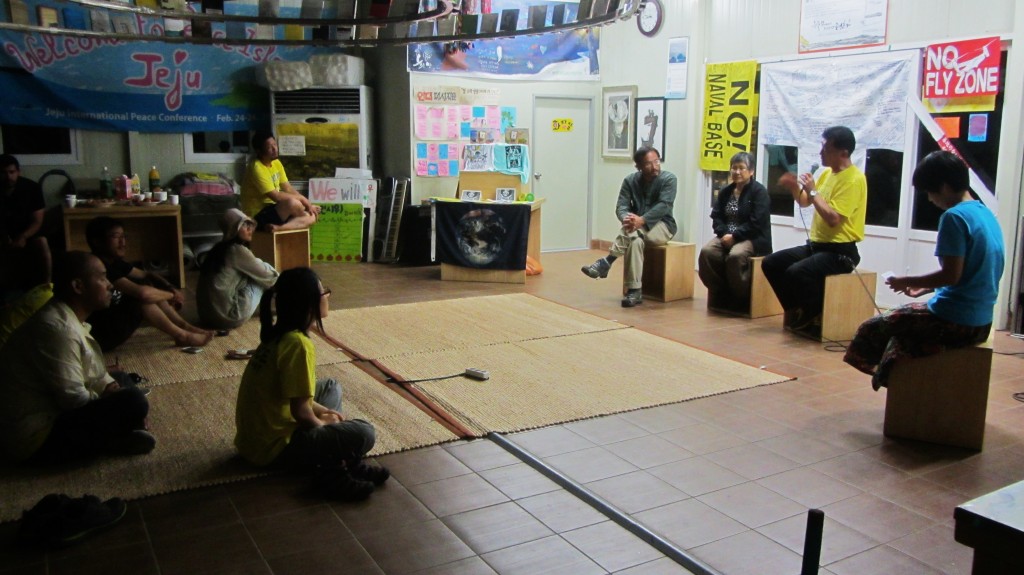
Brother Song, Jeong Young-Hee, and Mayor Kang chat in the Gangjeong Peace Center. On Wednesday, June 12, The Gangjeong International Team hosted an International Solidarity Talkshow during the daily candlelight vigil/gathering time in the Gangjeong Peace Center. The show highlighted recent solidarity trips taken by Gangjeong villagers and activists. There were three guest to the “show”. The first was Mayor Kang, who recently returned from Berkeley, California, where he attended and participated in the Moana Nui 2013 Conference on June 1 and 2. Moana Nui is an international solidarity gathering, hosted of people from by the International Forum on Globalization (IFG) and Pua Mohala I Ka Po, in cooperation with Oceanic Coalition of Northern California (OCNC). The theme was “PEOPLES OF THE PACIFIC–CONFRONTING MILITARIZATION, RESOURCE THEFT, GLOBALIZATION & THE PACIFIC PIVOT”. 45 speakers from 20 nations were there, including Mayor Kang, who spoke about the Gangjeong struggle as a Pacific resistance movment.
Second, Village Women’s Committee Chairwoman Jeong Young-Hee, who recently returned from an extensive speaking tour across the U.S., including Hawaii. For around 20 days starting at the end of April, she visited 6 different areas including Hawaii, Boston, Maine, New York, San Francisco and LA. There she shared about Gangjeong and her personal struggle at a variety of events, including a shared talk with Professor Noam Chomsky. And third, Dr. Song Kang-Ho (Brother Song) who has just come back from a trip to Okinawa. He was invited for May 18 which was the 40th anniversary of the reversion of Okinawa from U.S. Control back to Japanese administration. Aside from joining the events, he visited many areas to share about Jeju and talk about the movement for demilitarized peace island solidarity. For International Team member Silver was the host and emcee for the night, creating both a fun and thoughtful atmosphere. The “stage” was decorated with signed flags and signs of solidarity which the guests brought back with them.
The evening began with a trivia contest, with questions related to trips or the trip areas. Prizes included Jeju tangerine chocolate, solidarity t-shirts, and Indonesian coffee. After that each person was asked to give a 5 minute summary of their trip with pictures if they had them. It closed with a question and answer time.
During his talk and while answering questions, Mayor Kang said that he was impressed by the progressive atmosphere of Berkeley and felt that although it was home to many nobel prize winners, many people lived very frugally and not in a flashy manner. He also shared that he met many people from across the pacific ocean especially from small islands, and from them he found that they too were suffering like Jeju because of the endless pursuit of capital, neo-liberalism, and militarism. And they were all victims of war during WW2. He said that America claims they are working for “world security” with a “peace force” but in reality they are tormenting these small islands. He said he believes that Inter-Island Solidarity for Just Peace, beginning with a triangle of Okinawa, Taiwan, and Jeju is possible, because at the conference he felt a pressing need for forging bonds of solidarity at the conference. He also shared that in Berkeley there was a large 2000 year-old-tree which had a large hole in it that he could even climb inside. They were conserving that tree there and he was impressed and respected their effort to preserve their environment. On the other hand, I felt sad that America keeps its own values but at the same time seeks to destroy others values.
Among other things, Chairwoman Jeong told a story about an almost 70 year old native woman activist who she met in Hawaii and was very impressed by. She lost her parents when she was very young. Even back when her grandfather was still alive, that time was the 100th anniversary of U.S. colonization of Hawaii. Until now she has been working with dedication to recover Hawaii and has been to prison for her struggle. Also she met many Korean-American activists in the U.S. and was very impressed that even though Gangjeong is not their hometown they work hard to fight for Gangjeong. She said she was encouraged a lot by many American’s support for the Gangjeong struggle, but at the same time many overseas Koreans and Korean-Americans who were indifferent. She said that she even yelled at one guy who seems like a Korean government agent. She also shared that she learned a lot from the experience and she hoped that other villagers would get a chance to do the same.
Finally, Brother Song talked about the similarities between Jeju, Taiwan, and Okinawa. He said that all of them have similar histories and are suffering by powerful countries in similar ways. In the effort to create the Inter-Island Solidarity for Just Peace Movement, he suggested that we start with these three places as a “trial triangle”. He told the story of an island controlled by Taiwan called “Lanyu” were China discarded nuclear waste there without discussion. It is ironic that all of the most beautiful islands are destroyed by powerful nations. He then shared that the islands which are weaker than Jeju need our solidarity and experience. Meanwhile, Okinawa which has fought for more than 68 years has managed to get some land back from bases but all the land is very polluted. However, more than land contamination, spiritual contamination is more dangerous. In Okinawa, there is an place called, “American Village” where the land has been returned. But the land was contaminated and the economy was dependent on the base, so the people struggled and eventually created an American style village to service U.S. military members, so that they could survive. He said that we need a strong vision for peace so that even if our land is contaminated and the base is built our spirit will not be contaminated. For example, in Gangjeong we can create spaces for peace activists to migrate, give land for refugees, build a peace park, and do peace education, basically creating one big peace village. To gather islands for the Inter-Island Solidarity for Just Peace movement, he suggested sailing on a boat between the islands. He also invited people from around the world to join the every-seven-year-event of the WCC (World Council of Churches) in Busan, Korea this October, where Gangjeong and the Inter-Island Solidarity for Just Peace Movement will be holding a workshop during the forum.
-
UNESCO totally cheated by Jeju Island Government
Related links: [May 27 to 30] A Renewal of the UNESCO Biosphere Reserve Status? The Jeju Sea is being killed now.
Navy and companies’ illegal dismantling of damaged caissons on the sea
(Source: Jeju Internet News, May 29, 2013/ Original source: Gangjeong Village Association)
1. Maintenance of UNESCO Biosphere Reserve despite massacre of nature?/ People’s letter to the UNESCO
Despite great mass killing of UNESCO sea creatures in the Gangjeong Sea, Jeju, it is reported that the UNESCO International Coordinating Council of the Man and the Biosphere program (MAB) adopted the report by the Jeju Island government in its evaluation on May 28, 2013. The evaluation is held every 10 year. The Jeju Island became to continue to hold the title of the UNESCO triple-crowned: The Biosphere Reserve, World Natural Heritage and Geology Park. Please see the very related and important post regarding the matter of the UNESCO renewal , here.
The Jeju Island was designated as the Biosphere Reserve in Dec. 2012. The total designation area is 30.94㎢, which is about 45% of the whole area of the Jeju Island, It includes the Halla National Park, Youngcheon (Young Stream), Hyodoncheon (Hyodon Stream), Moonseom (Moon Island), Beomseom (Beom/ Tiger Island), Seopseom (Seop Island) that were designated as the CORE Biosphere Reserves in 2012. (See the same article of the Jeju Internet News linked above)
The status of the UNESCO Biosphere Reserve in the Jeju Island. The scarlet areas and spots indicate the core zones of the Biosphere Reserve: Mt. Halla, Beom, Moon and Seop Islands. The blue areas are buffer zones while the pale blue areas are transition areas. (source: Jeju Internet News, May 29, 2013)
The National Network of Korean Civil Society for Opposing to the Naval Base in Jeju Island has sent a letter to the UNESCO MAB secretariat as of May 29, to request the UNESCO ‘objective reviews on the Jeju Biosphere Reserve,’ concerning about the ‘destruction and pollution of the Jeju Biosphere Reserve in relation to the Jeju Naval Base construction.’ Please see the letter in English in the site (Please scroll down mouse until you see the English part).
In its letter, it first raised on the matter of ‘inconsistent maps of the Biosphere Reserve Buffer Zone’ around the core Biosphere Reserve of the Beom Island (Tiger Island):
‘Inconsistent maps of the Biosphere Reserve buffer zone brings confusions and raises doubts on the Government’s performance on monitoring the management and preservation of the entire Jeju Biosphere Reserve.” (See the letter for details)
It also made clear that the ‘sea route of the Jeju Naval Base would cut through the buffer zone’: ‘In the last World Conservation Congress held in September 2012, the Government insisted that the Jeju Naval Base construction does not violate the Biosphere Reserve. However, in any of above mentioned three maps, the sea route of the Jeju Naval Base would cut through the buffer zone, which would bring negative impacts on the Biosphere Reserve. The Government did not mention about these concerns in its Periodic Report submitted in September 2012.’
Thirdly, it raised on the matters of ‘pollution and damages of adjacent waters by the Jeju naval base construction,’ with the examples of unreliable silt-protectors and mass-killing dismantling works of damaged caissons on the sea.
Despite the letter, according to the the Jeju Island government who stated on May 29 , “the UNESCO MAB-ICC made an overall evaluation that ‘the Jeju Island is faithfully carrying out the Biosphere Reserve network rules and regulations,’ according to its advisory committee evaluation result. The MAB-ICC adopted the periodic reviews from the six regions of Canada, Germany, India, Paraguai, Mexico, and Jeju Island, among 55 regions, without special demand items. It adopted periodic reviews from the other regions with recommendation and demand items.” the same article reads. (See the article)
According to the article, ‘the Jeju Island government delivered that it included the physical character of the Island’s Biosphere Reserve; types of creatures’ habitats; activities within the Biosphere Reserve; activities on study, monitoring; education & training and public relation; management, policy, budget on its biosphere reserve.’ It also added that it ‘introduced Gotjawal, Oreums, inner land wetlands, and soft coral habitats as the habitats of special concern, while introducing stone culture and sea-diving women’ lives as its traditional culture.’
Did they ever report on the current on-going destruction and killing of UNESCO Gangjeong Sea by the naval base construction(destruction)? Probably NONE but with lots of cheats ! The UNESCO is dammed to be cheated by the Jeju Island and ROK governments. You may see the ROK government document to the MAB-ICC, here, which conceals many serious matters of ROK government’s environmental destruction in the UNESCO Biosphere Reserve, especially in the Jeju.
2. People file for a lawsuit against the navy and Samsung
On May 31, the ROK Day of Sea, some groups such as the Office of Jang Hana, National Assembly woman, Hot Pink Dolphins, and the Gangjeong Village Association filed for a lawsuit accusing the ROK navy, Samsung and Daelim, especially in relation to the navy and companies’ massacre of sea creatures with their thoughtless dismantling works of damaged 6 caissons, which started on May 5, this year, the Children Day in Korea. (See the accusation document in Korean, here).
The groups along with the members of the Seoul and Gyunggi branches of ‘Gangjeong Friends’ also had a press conference in front of the Seoul Central District Prosecutors’ Office on the same day.
Jang Hana, National Assembly woman talking and holding accusation document against the navy and corporations such as Samsung C & T, during the press conference on May 31. People wore the hand-made hats of endangered species in Gangjeong by the naval base construction(destruction)
Jo Yak Gol, member of Hot Pink Dolphins and a peace keeper of Gangjeong speaks during the conference on May 31. (Source/ Original Source: Voice of People, May 31, 2013)
According to Jang Hana, National Assembly woman: “The navy’s behavior of contaminating the sea ecology system in the Gangjeong Sea, by its dismantling process of damaged caissons underwater, bringing the very poisonous cement powders and concrete lumps in the sea is in violation of item 2 of article 22 of the maritime environment management.
The item 2 of the article 22 of the maritime environment management defines that “nobody should leak contaminating material that occurs in the maritime space such as maritime facility, beach resort, and mouth zone.” The punishment for the violation of it is up to two years’ imprisonment or up to 20 million won fine.
The people also reminded that when the World Conservation Congress was held in Jeju, 2012, there was a controversy of environmental destruction on the damaged caissons by typhoons. At the time, Captain Yoon Seok-Hwan stated in the press conference, that the navy plans to “float damaged caissons and then dismantle and dispose those ON THE LAND or dispose those in the ways not badly affecting environment. We will NEVER use the way such as underwater blast.” (See a Korean article, here) .
Go Gwon-Il, Village chairman of the Stop the Naval Base Project speaks during the press conference on May 31. The banner reads, ‘Immediately stop the Jeju naval base construction (destruction) that destroys maritime ecology system. ‘(Source/ Original source: Newsis, May 31, 2013)
However, that promise has never been kept. The navy is openly dismantling those caissons ON THE SEA, carelessly blowing out poisonous cement powders and lumps into the sea. Its disastrous result could be seen on the SOS teams’ May 15 video. “Even though the navy and Samsung say that they would dredge the cement on the sea bottom, there is really no way to dredge all the chopped-up parts of cement because those powders are spreading far into the sea by the strong currents of the Gangjeong Sea. It is already illegal to throw down concrete cement, poisonous waste, into the sea.” (from people’s accusation document)
3. Three recent important videos on the navy’s destruction of Gangjeong sea
(1) The navy and companies’ illegal dismantling of damaged caissons on the sea
It is a vivid scene of navy’s illegal dismantling of damaged caissons on the sea, which started on May 5. (Video by Moetppuri Park, edit by Ryu Dong-Kyun)
Seven caissons were destroyed by the typhoons such as Bolaven on Aug. 29, 2012. The whole production costs of those caissons are 35 billion won. The ROK Ministry of Construction and Traffic has concluded in 1998 that the caisson construction method is impossible in the southern part of Jeju, after the result of a year’s investigation. It is because of severe typhoons and currents to the total destruction of harbors in the Seogwipo area, the southern part of Jeju. (See the recent Korean article, here). Especially, the Gangjeong village is of a protruded out geography in its coast. The villagers have warned the navy numerous times that the village geography itself is impossible for any huge harbor, not to mention naval base. Despite that, the navy has enforced the construction (destruction). It is only forthe profits of big corporations such as Samsung.
(2) The UNESCO Gangjeong Sea being killed by the naval base construction (destruction)
(Video by Save Our Sea team on May 15, 2013)
‘While heavy metal-poisonous materials such as leaking earth and sands, concrete lumps and cement powders are injected into the sea as they are by the illegal naval base construction(destruction), the silt protectors never properly work because of unreliable installation and restoration of their damaged status… The Gangjeong Sea where the endangered species such as the Indo-Pacific bottle nose dolphins, red-feet crabs, soft corals have been playing is being killed. There hardly is no trace of living creatures in the bottom of the sea. Only sediment materials can be touched. The damage on the fisheries by the illegal naval base construction (destruction) is extended into Beophwan and Wolpyong, nearby Gangjeong’ (SOS. Source)
You may painfully compare the above video with the below which was taken in 2009, before the destruction of sea by the naval base construction.
(3) Illegal quarrying, transportation, and reclamation of sand and stones.
(Video by Kim Bok-Chul, edit and arrangement by Dungree(Park Sung-Soo)
The Jeju naval base project is already infamously illegal in the sense of dual MOU, violation of EIA, violation of law on the cultural treasure, layout flaw, manipulated fake simulation. It was disclosed by a construction worker last October that the Samsung C & T is building unreliable caissons, using the reinforce rods under-standard, which results in easy destruction of caissons by typhoons.
Not only that. The video discloses the illegal quarrying, transportation and land-filling of sand-stones by the companies.
On Jan. 31, this year, a peace activist, Mr. Kim Bok-Chul traced a truck from the Hwasoon port and Gangjeong and found that the stone-quarrying site located in the Mooreung-ri, Daejung-eup, Seogwipo City is illegal. Given the record, it can be estimated that tens of thousands of illegal sands and stones have been transported for 40 days around Jan. 31. Those illegal stones would never properly work in the basic construction of the base.
It has been also known that there are about nine transportation companies of which trucks commonly violate legal speed, freight amount, central line and traffic signs.
Putting sands and stones in the sea is also done in violation of the EIA. The silt-protectors have never properly functioned but rather contributed to the destruction of environment.
The navy and company should stop destruction of nature with illegal methods which are only for reduction of construction costs. The sea is of the soft coral habitats, which are ROK natural memorial NO. 442, as well as the UNESCO Biosphere Reserve.
While the Seogwipo Coast Guard is investigating on the illegality of sand and stones, the Seogwipo City and Seogwipo Police should also thorough examine the illegality of construction (destruction) rather than oppressing protesting people in violation of their human rights.
-
Morning with the Mayor | Organizing Notes
Reblogged with permission from: MORNING WITH THE MAYOR | by BRUCE K. GAGNON *
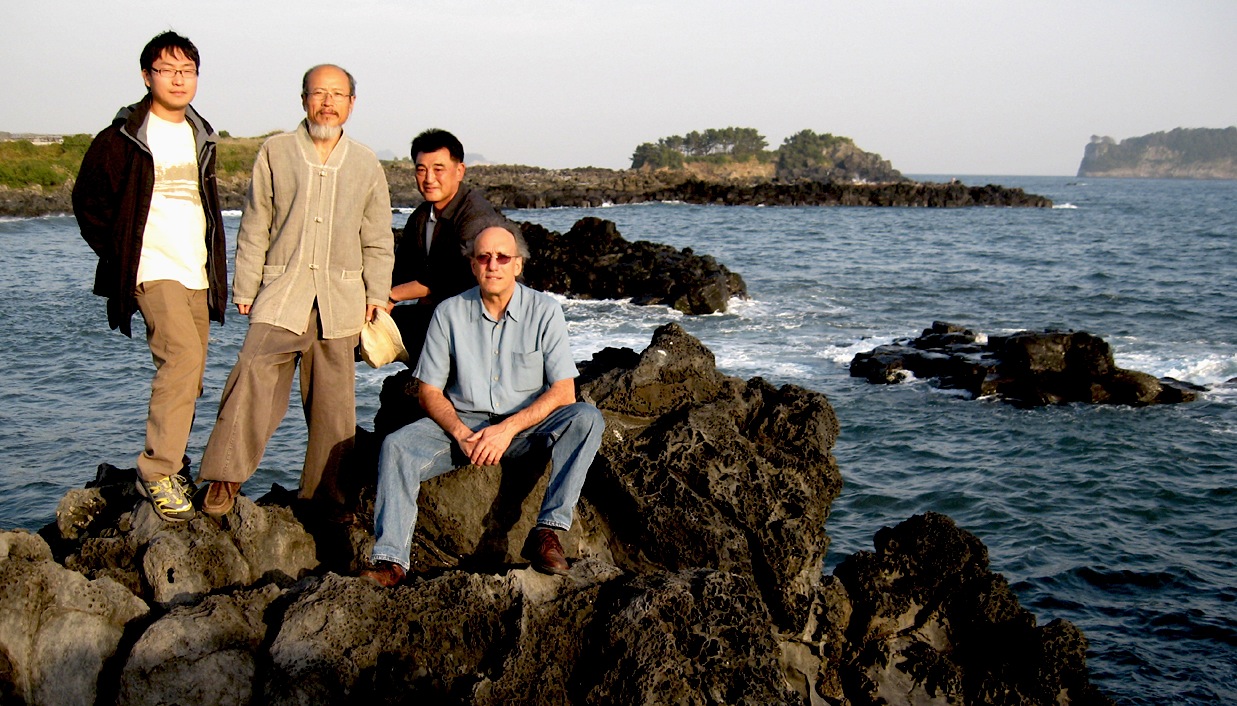
On my first trip to Gangjeong village Mayor Kang (just behind me in dark jacket) took me to see the place where the fresh water stream flows into the sea. This was to be one end of the massive Navy base now being built in the village. At that time I was able to see the undisturbed beauty of the coastline. I arrived in Berkeley, California last night about 7:30 pm and was able to join a group of conference participants at a Chinese restaurant where they were having dinner together. When Gangjeong village Mayor Kang saw me he rose and gave me a big hug. At that time there was no translator available so we didn’t get to have much conversation.
This morning at breakfast Mayor Kang arrived with a Korean professor from the university. The mayor had just come from doing an interview for Democracy Now which is supposed to air on Monday. Koohan Paik (Hawaii) was on the radio with the mayor. Koohan has been a great Jeju supporter and made it possible for the mayor to speak at this event on behalf of the village.
During breakfast the mayor told me that when I first came to visit Gangjeong he remembers me talking about space technology. He told me that he now understands much better what I was saying. He said he believes that the US is bringing the South Korean government into the military space program as a junior partner to help control China. I was happy to hear that he has put all the pieces together.
A translator took the mayor and I for a long stroll through the vast University of California campus. We went to the top of a huge bell tower that enabled us to see the entire San Francisco bay area. While we were looking out over the bay I told the mayor how much their non-violent resistance has inspired people all over the world due to their strong spiritual grounding. He told me that they made a conscious decision to act in that way to help them deal with the obvious depression and sadness that comes from the Navy base construction project. He said that if they were going to resist then they had to find a way to stay connected to what was good in nature and in each other. He offered to teach me the dances…
*Reblogged posts do not necessarily reflect the opinions or views of Save Jeju Now
-
The Island government’s shameful remarks and moves after the 2012 WCC Jeju
1. Island government attributes the cause of failure in invitation of the UN CBD COP to people’s WCC protest
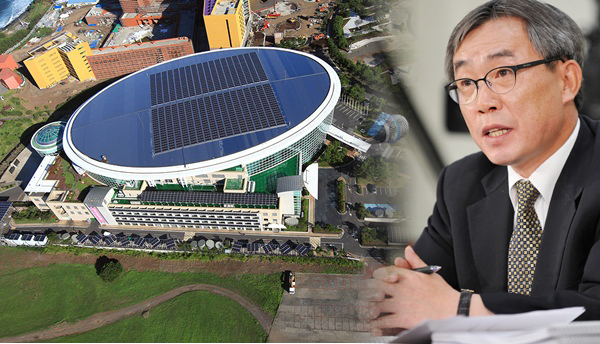
Image by Jeju Sori, May 2, 2013/ Kim Sun-Woo, vice-governor of Environment and Economy, Jeju Island. Some representing Jeju internet media criticize the Jeju Island government to point out the protesters opposing the Jeju naval base project as the cause of its failure to invite the UN CBD COP 12 (UN Convention on Biological Diversity, 12th Conference of the Parties). For reference, the COP 11 was held in Hyderabad, India, from 8 to 19 October 2012.
It was April 30 that the ROK Ministry of Environment decided the venue of the UNCBD COP12 in Pyeongchang, Gangwon province.
The Jeju media reports on May 2 that Kim Sun-Woo, Vice-governor of Environment and Economy, talked about the things during the review process on the location of COP 12 in the meeting with the news reporters accredited to the Island government on the day.
According to Jeju Sori,
Vice-governor Kim introduced an episode saying that, “one of the judges raised an issue on a performance that the opposing groups against the Jeju naval base project carried out during the WCC. It was the most embarrassing inquiry to answer during the examination process.”
He was pointing out the performance in which each activist did not move lying inside the venue of the Convention Center where the WCC was held [from Sept. 6 to 15].
However, the Jeju Sori criticized his remarks:
‘His is in fact merely an excuse. The Island governnment started its activities on the invitation of COP 12 this year. It has been less than 4 months.
Not only its start was very late but it has not gathered Island people’s collective opinions on it. The Jeju Island government has also confessed that “we could not afford it because of the WCC.”
The remarks by the Vice Governor Kim means he was unreasonably venting his wrath to the Gangjeong villagers who are suffering from the naval base project for seven years.’
Media Jeju also wrote that it feels the shady Jeju Island government shameful to attribute its failure on the invitation of the COP 12 to the protesters.
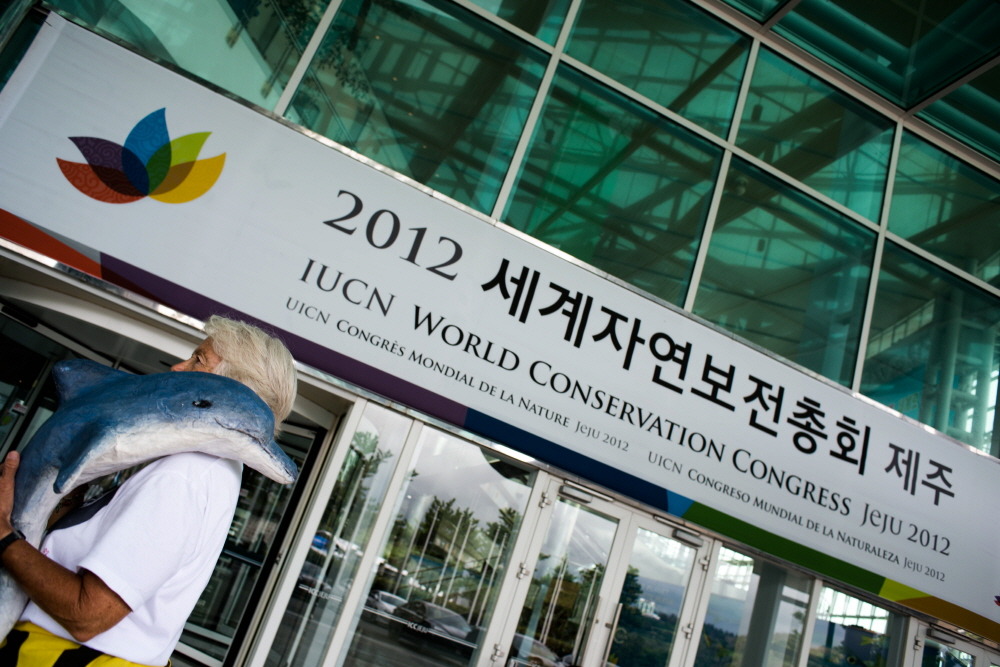
Photo by Jeong Dauri (source)/ An international protester against the Jeju naval base project holds a doll of Indo-Pacific bottle nose dolphin that remain only 100 in Jeju and throughout Korea, in front of the WCC venue, during the 2012 WCC Jeju. For more photos, see the source. 2. Otherwise, the Jeju Island government is driving for the project for the Jeju World Leaders’ Conservation Forum, as a following measure for the Jeju declaration adopted in the 2012 WCC Jeju. The Jeju Island is to poster the forum as the Korean version Davos forum.”
The Jeju-based Halla Ilbo has reported on Jan. 30, 2013, that consultation between the Ministry of Environment and Jeju island government started on the discussion of participation size, program, agenda, budget size, organizing, establishment of foundation, methods of fundraising. Their aim is to hold its 1st forum in April, 2013.
Its strategy is to jointly sponsor the forum by the IUCN, Ministry of Environment, and Jeju island government and presents a new model for an environment meeting that presents a new vision by the discussion by ‘the highest-ranking leaders in the environment field.’
It is ironic and hypocritical that the Jeju Island government who joins the destruction with the naval base project in the Gangjeong village promotes the Jeju as a world environment herb that is centered on the big oligarchies such as Samsung, the main construction company of the Jeju naval base project.
3. The Island government’s such shameful remarks and moves are in line with the government propaganda to attribute to the opponents against the base project as the ‘pro-North Korea left wing.’
It was on March 18, 2013, that a Korean media, Hankyoreh disclosed that Won Se-Hoon, chief of the ROK National Intelligence Service interfered in the Pre-Presidential election by ‘ordering his employees to interfere directly in national politics.’ The results were employee’s black comments in on-line sites to defame the opponents against the Jeju naval base project. The article reads:
‘Several similarities were detected between Won’s messages and messages posted by Kim on the site Today’s Humor. Her messages also contained criticisms of opponents to the building of a naval base on Jeju Island, praise for former President Lee Myung-bak’s overseas tours, and characterizations of opposition politicians as “pro-North Korea.” The similarities support claims that she acted according to the NIS chief’s orders.’
Some groups including the Office of Jang Hana (National Assembly woman, Democratic United Party), Democratic Lawyers’ Association and People’s Solidarity for Participatory Democracy (PSPD) have filed for lawsuits on Won Sei-Hoon for the charge of defamation on March 21.
The inter-connections among the Jeju Island government, navy, police, and National Intelligence Service is nothing new. The 812th program of the ‘PD Note,’ a documentary titled, “Why is the Gangjeong Village, Jeju, So Angry?” broadcast on May 5, 2009 has already disclosed on the secret meeting by those institutes, which shows the Jeju Island government, NIS, navy, and police’s intentional and systematic strategy of division and oppression of the village community for the enforcement of naval base construction. See here.
For the Korean leaders, criticism on Won Sei-Hoon’s policies in relation to the WCC and protesters can be seen here, in detail.
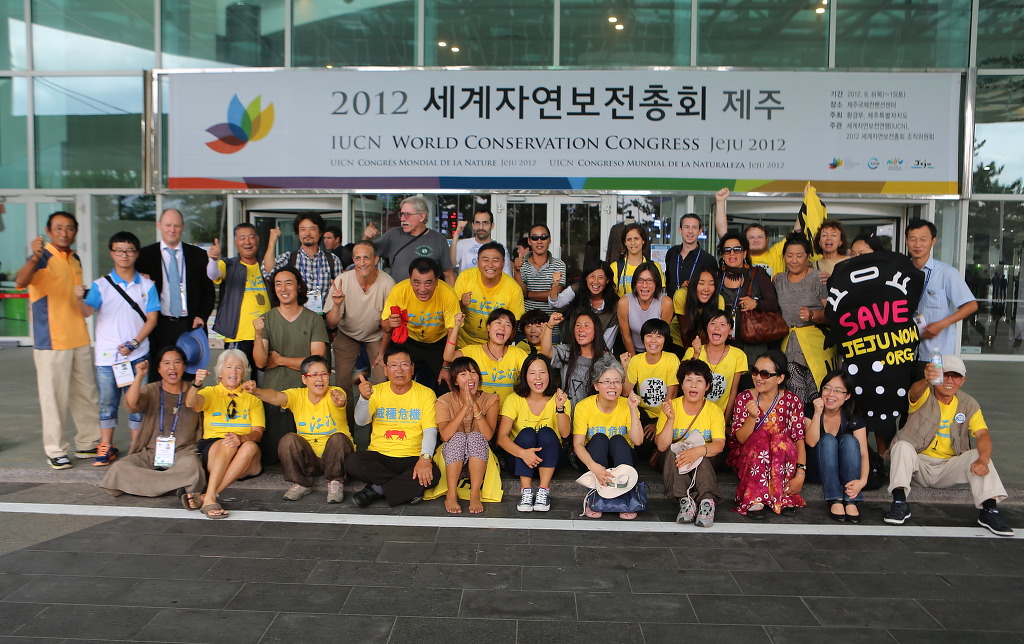
Photo by Cho Sung-Bong (Source)/ Villagers and activists opposing the naval base project on the final day of 2012 WCC Jeju, Sept. 15, 2013. Many NGO people from the world who joined the event have expressed strong support to the struggle. For more photos, see the source.







